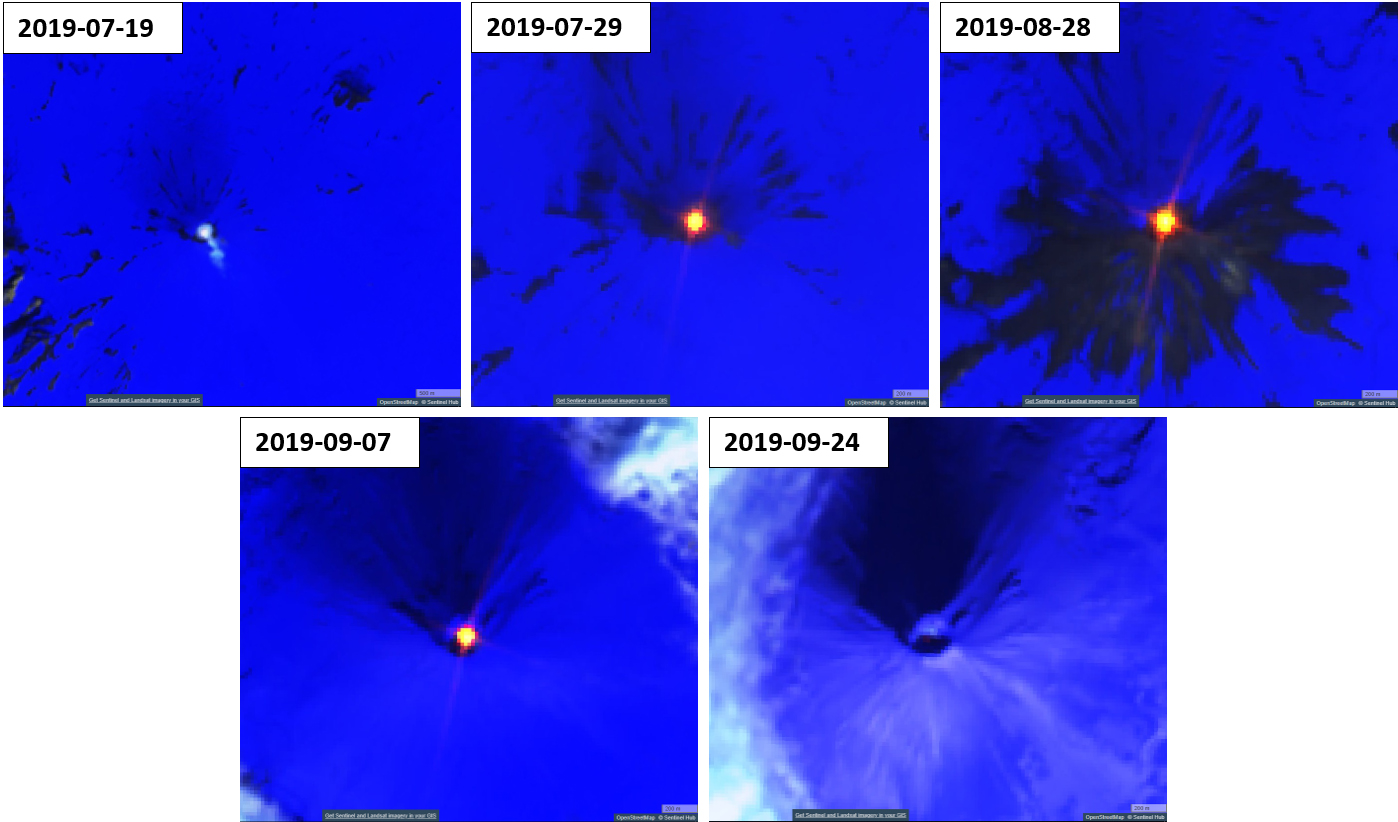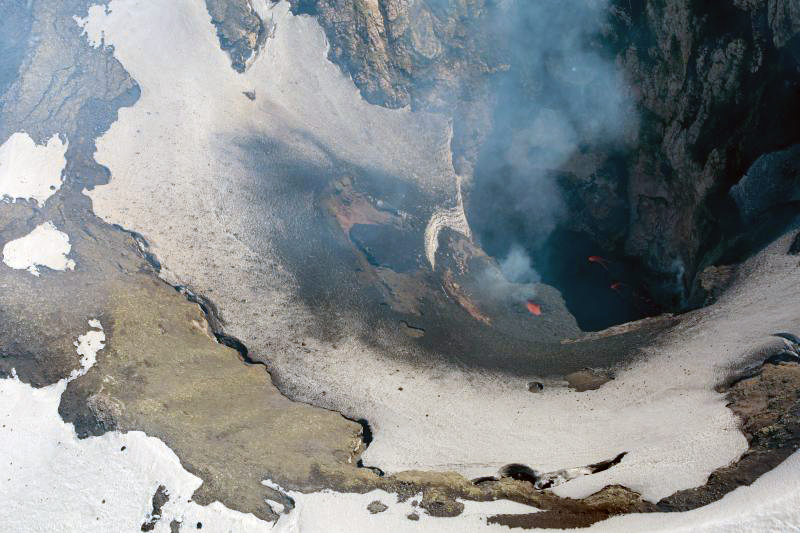Report on Shishaldin (United States) — October 2019
Bulletin of the Global Volcanism Network, vol. 44, no. 10 (October 2019)
Managing Editor: Edward Venzke.
Research and preparation by Kadie Bennis.
Shishaldin (United States) Active lava lake and spattering on 23 July 2019; minor explosions and lava fountaining on 17 August
Please cite this report as:
Global Volcanism Program, 2019. Report on Shishaldin (United States) (Venzke, E., ed.). Bulletin of the Global Volcanism Network, 44:10. Smithsonian Institution. https://doi.org/10.5479/si.GVP.BGVN201910-311360
Shishaldin
United States
54.756°N, 163.97°W; summit elev. 2857 m
All times are local (unless otherwise noted)
Recent activity at Shishaldin, located on Unimak Island within the Aleutian Islands, has included a lava eruption in the summit crater, thermal anomalies, elevated seismicity, and gas-and-steam and ash plumes (BGVN 41:11). This report describes minor gas-and-steam emissions, increased seismicity, thermal anomalies, lava fountaining accompanied by minor explosive activity, and a spatter cone. The primary source of information is the Alaska Volcano Observatory (AVO). This report updates activity through September 2019.
Volcanism was relatively low between March 2016 and early July 2019; increased seismicity and steam emissions were detected in December 2017, but the activity declined in February 2018. Elevated seismicity and some thermal anomalies accompanied by incandescence observed in satellite imagery (when not obscured by clouds) returned in mid-July 2019 (figure 12).
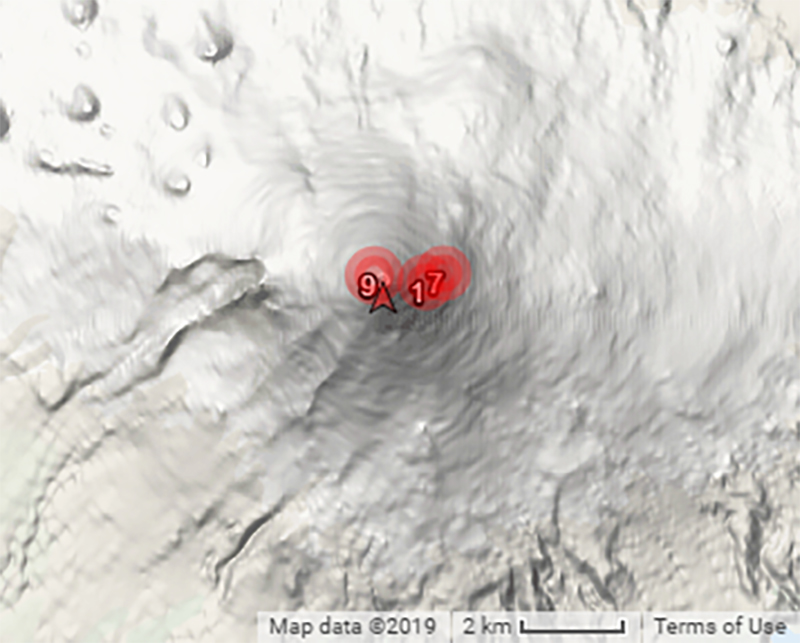 |
Figure 12. Summary graphic of MODVOLC thermal alerts measured over Shishaldin during July-September 2019. Courtesy of HIGP - MODVOLC Thermal Alerts System. |
Elevated surface temperatures and low-level seismic tremors remained elevated through September 2019 (figure 13). Field crews reported an active lava lake and minor spattering within the summit crater on 23 July 2019 (figures 14 and 15). Satellite imagery showed the presence of a small spatter cone and some lava flows within the summit crater on 28 July. A small steam plume was observed in satellite imagery and webcam images on 29 July, 20 August, and 30 September.
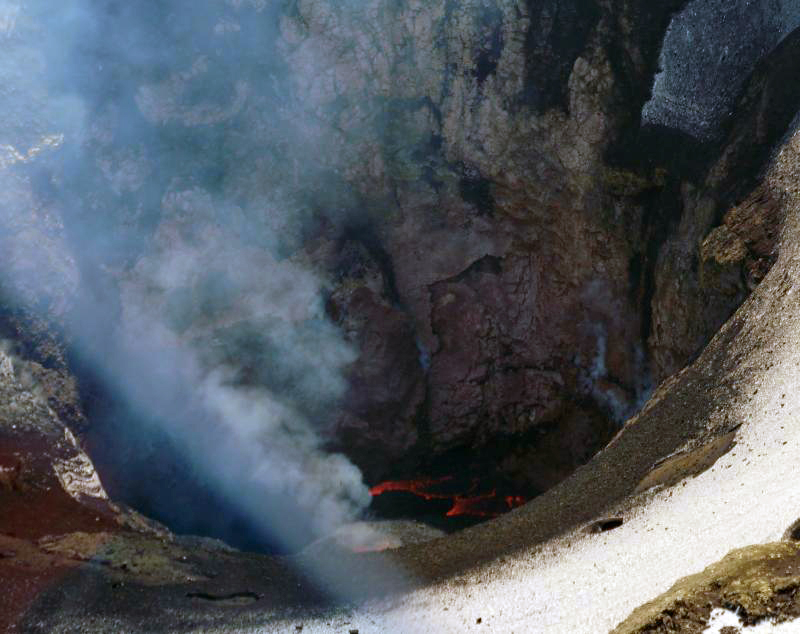 |
Figure 14. Photo of surface lava within the summit crater at Shishaldin taken on 23 July 2019. Photo by David Fee (color corrected); courtesy of Alaska Volcano Observatory (AVO). |
On 17 August 2019, a video taken by NOAA during an overflight showed repetitive minor explosive activity and low-level lava fountaining within the summit crater. This activity may have continued through 24 September, according to AVO. The spatter cone grew slightly in August and September, partially filling the summit crater. Accompanying lava flows also grew slightly during this time.
Satellite data from 3 September showed SO2 emissions and elevated surface temperatures. Satellite imagery and tiltmeter data recorded a collapse and slumping of the summit crater floor, which may have occurred on 19 September. In the last few weeks of September, seismicity and surface temperatures decreased to slightly above background levels.
According to MIROVA (Middle InfraRed Observation of Volcanic Activity) data from MODIS satellite instruments, more frequent thermal anomalies were detected in mid-July 2019 and remained elevated through early September (figure 16).
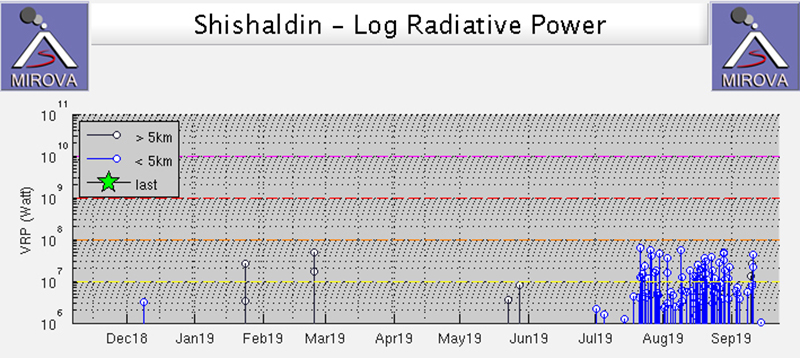 |
Figure 16. Thermal anomalies increased at Shishaldin from mid-July 2019 through early September and then abruptly stopped as recorded by MIROVA (log radiative power). Courtesy of MIROVA. |
Geological Summary. The symmetrical glacier-covered Shishaldin in the Aleutian Islands is the westernmost of three large stratovolcanoes in the eastern half of Unimak Island. The Aleuts named the volcano Sisquk, meaning "mountain which points the way when I am lost." Constructed atop an older glacially dissected edifice, it is largely basaltic in composition. Remnants of an older edifice are exposed on the W and NE sides at 1,500-1,800 m elevation. There are over two dozen pyroclastic cones on its NW flank, which is covered by massive aa lava flows. Frequent explosive activity, primarily consisting of Strombolian ash eruptions from the small summit crater, but sometimes producing lava flows, has been recorded since the 18th century. A steam plume often rises from the summit crater.
Information Contacts: Alaska Volcano Observatory (AVO), a cooperative program of a) U.S. Geological Survey, 4200 University Drive, Anchorage, AK 99508-4667 USA (URL: https://avo.alaska.edu/), b) Geophysical Institute, University of Alaska, PO Box 757320, Fairbanks, AK 99775-7320, USA, and c) Alaska Division of Geological & Geophysical Surveys, 794 University Ave., Suite 200, Fairbanks, AK 99709, USA (URL: http://dggs.alaska.gov/); MIROVA (Middle InfraRed Observation of Volcanic Activity), a collaborative project between the Universities of Turin and Florence (Italy) supported by the Centre for Volcanic Risk of the Italian Civil Protection Department (URL: http://www.mirovaweb.it/); Hawai'i Institute of Geophysics and Planetology (HIGP) - MODVOLC Thermal Alerts System, School of Ocean and Earth Science and Technology (SOEST), Univ. of Hawai'i, 2525 Correa Road, Honolulu, HI 96822, USA (URL: http://modis.higp.hawaii.edu/); Sentinel Hub Playground (URL: https://www.sentinel-hub.com/explore/sentinel-playground).


